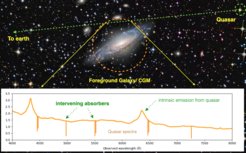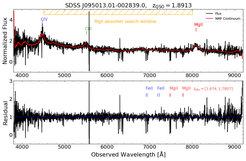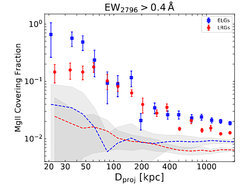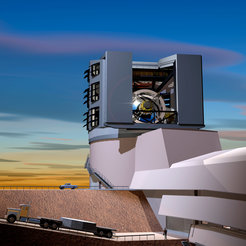The cool circumgalactic medium in SDSS galaxies

Basic setup of an absorber-galaxy cross-correlation study, where the CGM is observed in absorption against a bright background quasar.
The unseen dark matter halos that surround all galaxies make up most of the mass of galaxies. Only a very small fraction (<~ 10%) is made of ordinary matter (or baryonic matter) and this can be probed with absorption lines. What is even more exciting: the metals that we see in the spectra of background objects can trace gas flows in action, i.e. gas flowing in and out due to various processes. These gas flows play a pivotal role in the formation and evolution of galaxies, implying that our understanding of galaxy formation is limited by our current understanding of this gas (also called the circumgalactic medium or CGM).
Large sky surveys performed with ground and space-based telescopes such as the Sloan Digital Sky Survey (SDSS), Keck, the Very Large Telescope (VLT), or the Hubble Space Telescope (HST), have significantly deepened our understanding of the CGM over the past two decades. One of the most powerful tools have been so-called ‘transverse absorption line studies’, where the CGM is observed in absorption against a bright background source such as a quasar. Different metal absorbers detected at redshifts smaller than the redshift of the background source, i.e. between the source and us, provide direct observational constraints on the gas flows around galaxies at different epochs.

Example quasar spectrum, where the Mg II absorbers are detected with our automated pipeline. The two panels show the normalized continuum-fitted quasar flux (top) and residual (bottom) along with two intervening Mg II absorbers (shown in red).
Figure 1 shows a schematic diagram describing the quasar absorption lines, where metal species in different ionization states trace different phases of the CGM. For example, ionized Magnesium (Mg II) traces the cool CGM (~ 10,000 K) and ionized carbon (C IV) traces the warm phase (~ 100,000 K). However, detecting absorption features in millions of spectra and associating them to galaxies is quite challenging and laborious, and a large ensemble of absorber systems is required to perform any meaningful statistical study.
To study these gas flows, we connect Mg II absorbers in background quasars with foreground galaxies. We use our automated absorber detection pipeline (described below) to identify the Mg II absorbers in about 1 million quasars from the latest SDSS data release (SDSS DR16) and connect them to about 1.3 million galaxies, also from SDSS DR16. These large samples provide us with an unprecedented opportunity to investigate the nature of cold gas absorption for star-forming and passive galaxies.

The Mg II covering fraction around star-forming (blue) and passive galaxies (red) along with covering fractions expected around the random samples (dashed lines). The star-forming galaxies have a pronounced excess relative to the passive galaxies within about 50 kpc.
With a very robust statistical analysis, we could characterize the scale dependence of Mg II with greater accuracy than in previous work. We find a strong enhancement of Mg II absorption in the central ~ 50 kpc of star-forming galaxies relative to luminous but passive galaxies (Fig. 3). Beyond 50 kpc, there is a sharp decline in Mg II for both kinds of galaxies, indicating a transition to the regime where the CGM is tightly linked with the dark matter halo.
Moreover, Mg II correlates strongly with the star formation rate for star-forming galaxies, indicating that stellar activity plays an important role in enriching the metal contents in the CGM. On scales of a few hundred kpc, we find that the average total Mg II equivalent width per absorber dips below the characteristic field value, both for passive and star-forming galaxies. This dip is possibly related to gas inflow processes onto dark matter halos. In summary, our analysis implies that cool circumgalactic gas has a different physical origin for star-forming versus quiescent galaxies.
Automatic pipeline

Artist rendition of the Vera Rubin Observatory on the Cerro Pachón ridge in north-central Chile, showing the primary mirror of the telescope. This facility is under development and will open up the study of circumgalactic gas tremendously.
In our work, we also develop an automated pipeline to estimate the optical continuum of quasars and to detect intervening metal absorber systems in their spectra. Our pipeline is based on a matched kernel convolution technique and adaptive S/N criteria. We run this pipeline on ~ 1 million quasars from SDSS DR16 and have compiled the largest metal absorber catalog to date, consisting of ~ 160,000 Mg II absorbers and ~ 70,000 Fe II systems. The full metal absorber catalog with description is publicly available here.
Our automated pipeline is quite general in detecting doublet features in quasar spectra. It is optimized and supports parallelization to run efficiently on millions of quasar spectra. In the future, large imaging surveys such as the Large Synoptic Survey Telescope at the Rubin Observatory will provide enormous datasets of galaxies, up to higher redshifts, and with high-quality imaging. Together with upcoming large spectroscopic galaxy surveys such as PFS on the Subaru telescope, statistical analyses of the circumgalactic medium will be a powerful tool to understand the formation and evolution of galaxies across cosmic time.















